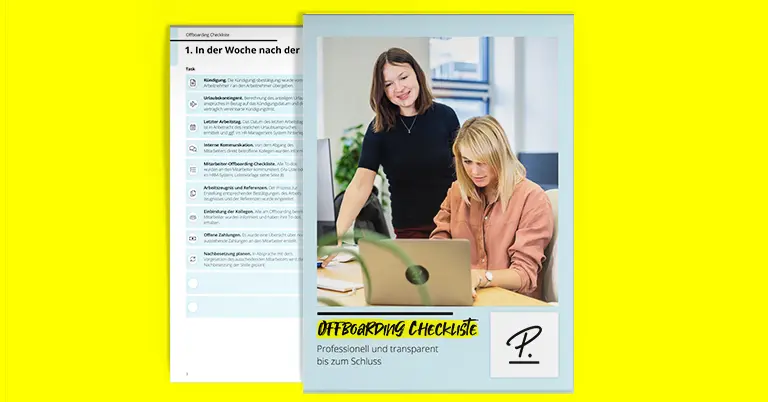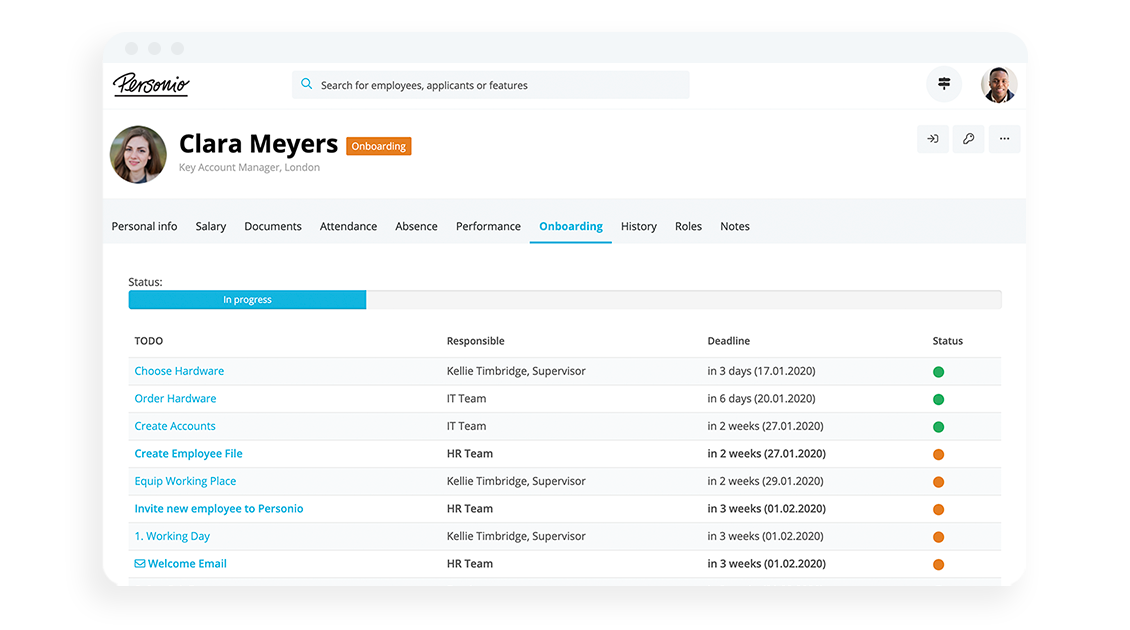27. June 2019
How to Get to the Right Onboarding Concept

HR has a key role in the onboarding process. It prepares the concept and informs everyone involved within the organization. HR controls the process so that every new recruitment reliably triggers a systematic and smooth induction process.
Our onboarding checklist helps you with organising and preparing everything necessary. Download it here!Why Does Onboarding Matter for New Employees?
A new employee's onboarding will only be successful if everyone involved – whether supervisor, safety officer, or office manager – knows what is required of them, and all are working together. Ideally, HR controls the process so that with every new recruitment, onboarding happens smoothly and at a constant quality level.
Thereby, it is especially important that you do more than just send out a checklist to all managers once (a customizable template is available here). As the driving force, you will approach all relevant departments from IT to office management well ahead, and clarify which details they require when, so that a laptop, access card, etc. are ready for the new recruit in time. This is the only way to ensure that your new initiatives will work long-term.

Tip: Ask what has gone wrong in the past. If nothing had gone wrong, you wouldn’t be working on a new process right now.
How Do You Control The Onboarding Process?
Here are some of the things that you can consider when it comes to the onboarding process:
Prepare a concept that covers the different tasks within the five stages of onboarding and that stipulates which internal business functions will be responsible for these tasks, and when.
It is important to clarify responsibilities and required lead times early, regarding items such as worktime recording and access cards, employee ID, office stationery, computer, software, and access permissions. The same applies with regard to making the necessary data available for payroll accounting and opening an employee file. Allow for realistic lead times in your plan.
Compile all administrative steps and the technical and social responsibilities of each HR, manager, and team in a checklist. As the recruitment and onboarding of a new colleague are not usually part of a regular workday, a list that spells out each onboarding step will be very helpful with every new recruitment, and it will establish a routine. Download a checklist here that covers the most important points; these can be adjusted at any time to suit the framework and responsibilities within your organization.
You will relieve managers if the onboarding process can be automated with the help of
HR software. The automation simplifies the completion of each step, from administrative tasks to an induction plan. The HR software facilitates the creation of templates and allows you to allocate each task to the responsible person/department. This way, the onboarding process can be adjusted with each new employee to suit their individual function and role.
Once you have entered responsibilities and due dates, to-do reminders and deadline periods will pop up automatically on the screens of the people in charge. With one mouse click, they can mark the task as ‘Done’. The reminder function is particularly helpful to managers in connection with tasks that don’t immediately precede or follow the new employee’s first working days, such as the scheduling of feedback meetings after a few weeks. A further advantage for HR is that an overview of the current status of an employee’s onboarding process is always at hand.
A Faster Way to Productivity

Improve coordination during the onboarding process with Personio and keep track of progress without having to intervene.
Learn more hereHow to Foster a Positive Onboarding Culture
For the new employee’s first welcome, job training, and social integration to be successful, managers and colleagues must be committed to their actions.
Talk with team leaders and managers about the importance of onboarding, and assist with further training if necessary. A welcoming culture, technical and social familiarization, as well as team commitment during the onboarding process must all become natural.
Find out whether the new employee will require a tour of the company or training, and assist in organising these.
Include the executive leadership team: Mission meetings with all new employees are a good way to inform about the organization’s targets, values, and culture; they also foster a sense of community.
Holding regular feedback meetings with the relevant department, manager and new employee is important, as you will learn about any snags in the onboarding process and where you can make adjustments.
Create a PowerPoint template for the onboarding presentation to new employees. The relevant department managers then need to add some additional information in time for their new team member’s first day.
Conclusion
The better the organization and support of the onboarding process through HR, the easier it will be for all participants to introduce and familiarize the new employee successfully. By setting up a structured process – whether supported through a checklist or through onboarding software – you are ensuring that everyone involved knows exactly what to do. This leaves you with more time to work on onboarding content, and on the social relationship with the new employee. You don’t have to deal with the whys and the whos or the what and how, but instead you are facilitating a new colleague’s seamless integration.
Are You Looking to Optimize Your Onboarding Process?

Download our checklist template and add the steps that are specific to your company.
Download Our Guide Here